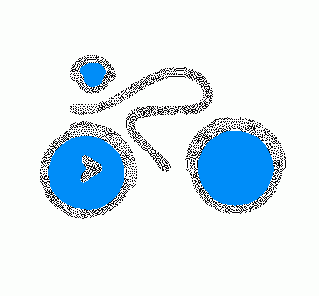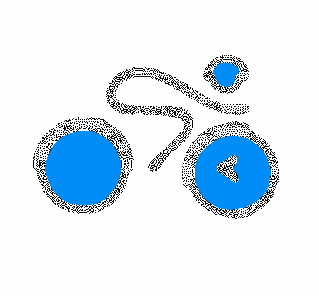| Newsletter - 2009 Archive |
 |
Cycling Club |
 |
| Newsletter - 2009 Archive |
 |
Cycling Club |
 |
Next--->
|
Brakes (and the Traction Circle) If you think about it, there is more power in a good set of brakes than in your legs. I know that on the track, it takes me about 15 seconds and roughly 150 meters to get from zero to 40 kmh. It probably takes me about a third of that, maybe 5 seconds and 50 meters, to get from 40 kmh to 0, on a dry road with good brakes. In my opinion, the two best brake technologies are disk and dual-pivot sidepull. Disks have greater brake swept area and their use during the winter doesn't wear out or mechanically weaken the rim. But the pads are thin and wear fast, and they theoretically require more pad pressure since they are closer to the center of the wheel. Sidepulls require less lever force because they're more mechanically efficient (a good cross between sidepull, with direct cable connection, and center-pull, with one calliper having a huge mechanical advantage), it's easier to get the wheel on and off, and the whole system is lighter and more elegant, although they lose out to disks on long, steep descents where rim brakes may overheat the rims. Cantilevers (and center-pull and U-brakes) absorb too much power at the transverse cable, although they may be the only option with fatter tires. V-brakes are useless with standard road levers, especially when the leverage-negating compensators (e.g., Travel Agents) are used. The pads are also way too thin. I don't know why most manufacturers put them on road tandems; this is a very inappropriate use. Cheapest option, I guess. Are you one of those people who still adheres to the archaic notion that you brake before you go into the turn, then release the brakes thru the turn? For race car drivers, the limiting factor in cornering is tire adhesion. This is probably even truer on a bicycle. The theoretical model racing drivers use for cornering speed is called the "traction circle." A traction circle looks like this: Draw a perfectly round circle. Then draw an X and Y axis with the intersection right in the middle of the circle, so you end up with what looks like a gun sight or a compass. The Y axis (up and down) represents acceleration at the North end, and braking at the South end. The X axis represents lateral force (sideways acceleration when cornering), with cornering to the right at the East end, and cornering to the left at the West. If we number the axes so that their intersection is 0 and the point at which they cross the circle is 10 or -10, then we can quantify our measurements. Where the X and Y lines cross the circle (0,10)(10,0)(0,-10)(-10,0) is the limit of tire adhesion, which is why this is called the traction circle. Stay inside the traction circle with any combination of acceleration, braking, and cornering, and the bike remains upright. Go outside the circle, and the tires slip (and you crash). As you can see, on straight acceleration or braking (0,10) or (0,-10), there's really no issue. If you accelerate too hard (maybe up a wet hill), the tire slips or you lay rubber. If you brake too hard, the rear tire leaves a skid mark. But if you take a corner too fast, either by entering it too fast for the tires to grip, or thru a combination of turning and braking that takes you outside the traction circle, you crash! So this is the intuitive basis for why you've been told to stop braking before you start turning. However, what the traction circle tells us is that there's plenty of room for what race car drivers call "trail braking." Although this sounds like what happens when you take a turn too hot and you end up in the bushes (breaking trail), it actually refers to the technique of staying on the brakes after you've entered the turn (0,-10), easing off (trailing) on the brakes as lateral acceleration increases (1,-9)(2,-8).. to (10,0), and then accelerating out of the turn as lateral acceleration decreases. All the time you're playing with the very edge of the traction circle. This is what raises race car and motorcycle racing to an art form, and is something that most ordinary motorists or street racers have no comprehension of. You are going into a turn without having slowed down enough for it, but you're still on the brakes, slowing as the bike leans. The more lean, the less braking. At maximum lean, you're completely off the brakes. The downside, of course, is that a car is allowed to skid (drift) slightly before traction is lost enough that it spins out. On a bike, any skidding (especially of the front tire) could be catastrophic, so you probably want to stay inside the traction circle, leaving a margin of safety. But the important lesson here is that you can continue braking into the turn, allowing you to corner that much faster. If you're doing 40 kmh, and the rated speed of the turn is 25 kmh, instead of braking and entering the turn at 25 kmh, you enter it braking at 32 kmh, slowing to 25 kmh at its apex. Now you only have to accelerate from 25 kmh back to 40, instead of having to accelerate from 20 kmh, or however much more speed you've lost since entering the turn. Don't forget too that if you are coasting around a turn, the often heard notion that putting all your weight on the outside pedal "lowers your center of gravity" is complete hogwash. Center of mass is determined by the attitude of your body in space, not by where you happen to feel pressure. Weighting the pedal merely gets your butt off the saddle so that your bike is now free to pivot around the bottom bracket. All you've really done is reduced the unsprung weight to just the bike, instead of you and the bike. This will likely help keep your bike on the ground on a rough road, but it does nothing to lower the center of mass. But in fact, on some roads, wet or with loose gravel, you probably want a high center of mass. But that's another article... Just be careful on those wet/gravelly roads, as the traction circle becomes considerably smaller.
- May 30, 2009 |